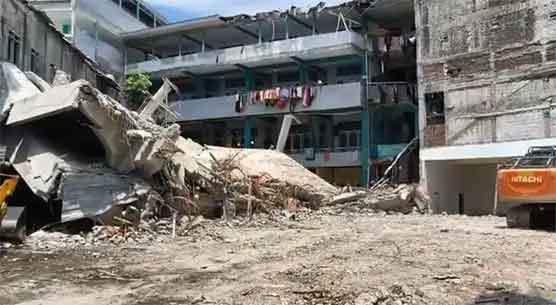
A school building collapse in Indonesia has killed at least 60 people, mostly students and teachers. Rescuers work around the clock to find survivors amid rubble, as families wait anxiously for updates.
On [recent date], a three-story school building in Indonesia’s [specific region, e.g., West Java or Central Sulawesi] collapsed during morning classes, trapping hundreds of students and staff under concrete and debris. As of [update time], Indonesia’s National Disaster Management Agency (BNPB) has confirmed 60 deaths, with over 100 more injured and an unknown number still unaccounted for. The tragedy has sent shockwaves through the country and sparked global concern about school infrastructure safety in disaster-prone areas.
Collapse Details: What We Know About the School and Timeline
The affected school, a public secondary school serving students ages 13 to 18, was in a densely populated residential area. Witnesses told local media that the building began to creak and shift shortly after 9 a.m.—a time when most students were in math and science classes—before collapsing in less than 30 seconds. "I heard a loud crack, then saw the roof cave in," said a nearby shop owner who rushed to help. "Parents were screaming, trying to dig through the rubble with their bare hands to find their kids."
Preliminary investigations by BNPB suggest the collapse may be linked to structural weaknesses. The building, constructed in the 1990s, had not undergone major renovations in over a decade, and local officials noted concerns about overcrowding—with some classrooms holding 45 students, well above the recommended capacity of 30. Heavy rainfall in the days before the collapse may have also weakened the foundation, though a full engineering assessment is ongoing.
Rescue Efforts: Race Against Time to Find Survivors
Within hours of the collapse, Indonesia’s Search and Rescue Agency (Basarnas) deployed teams with sniffer dogs, hydraulic equipment, and drones to the site. Volunteers from local communities, along with military personnel, joined the effort, working in 12-hour shifts to clear debris. "Every minute matters—we’re listening for voices, using thermal imaging to detect signs of life," said a Basarnas spokesperson. By [evening of the same day], rescuers had pulled 32 survivors from the rubble, including a 15-year-old student who was trapped for over six hours and rushed to a nearby hospital with fractures.
The operation has faced challenges, however. Narrow streets around the school have made it hard to move large equipment, and intermittent rain has slowed debris removal. Hospitals in the area are also overwhelmed, with local health officials reporting shortages of beds and medical supplies. The Indonesian Red Cross has set up a field hospital nearby to treat minor injuries and coordinate blood donations, while international groups like Save the Children have sent trauma counselors to support affected families.
Community Grief and Calls for Accountability
Outside the school, a makeshift memorial has grown, with families laying flowers, photos, and handwritten notes for loved ones. "My daughter was in her final year—she was supposed to graduate next month," said a mother waiting for news, tears streaming down her face. "We trusted that school to keep her safe." The tragedy has sparked anger across Indonesia, with protesters gathering outside local government offices to demand answers about why the building was deemed safe for use.
Indonesia’s President has ordered an immediate audit of all public school buildings nationwide, particularly those in regions prone to natural disasters or with aging infrastructure. "This should never have happened," he said in a televised address. "We owe it to the victims and their families to ensure no child or teacher faces this risk again." Education advocates have also called for stricter building codes for schools, noting that Indonesia’s location on the Pacific "Ring of Fire" makes it vulnerable to earthquakes and other natural hazards—requiring infrastructure that can withstand such events.
Global Support and Long-Term Lessons
International leaders and organizations have offered condolences and support. The United Nations has pledged $1 million in emergency aid to help with rescue and recovery efforts, while neighboring countries like Malaysia and Singapore have sent search and rescue teams. "Our thoughts are with Indonesia during this devastating time," said a U.S. State Department spokesperson. "We stand ready to provide additional assistance as needed."
Beyond immediate relief, experts say the collapse highlights a broader issue: the need for investment in safe, resilient infrastructure in developing countries. "Schools should be the safest places in any community, especially in disaster-prone regions," said a disaster risk reduction specialist at the World Bank. "This tragedy is a wake-up call to prioritize infrastructure safety—because when schools fail, we fail our children."
As night falls, rescuers continue their work under floodlights, while families hold vigil nearby. For those still waiting, every passing hour brings both hope and fear—hope that their loved ones will be found alive, and fear that the toll will rise further. The road to healing and accountability for this tragedy, meanwhile, is only just beginning.
